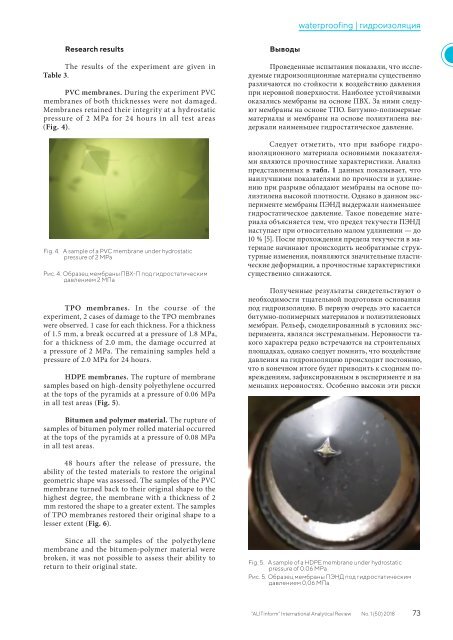AlitInform 50
“ALITinform” is a periodical that covers different aspects in production and applications of cement, concrete, and dry building mixtures. Pages of this journal offer contributions from leading Russian and International scientists, technologists and leading professionals, news from the stock markets, research laboratories, latest elaborations by producers and suppliers of modern building materials and equipment. The magazine goal is to unite on its pages the articles of the leading Russian and International specialists in the field of cement, concrete, dry building mixtures; latest news of the Russian and world building materials market, the traditions of peer-reviewed Russian scientific magazines and innovative informational approach of the contemporary printed media. The prime focus is on developments serving the purpose of rationalization of production, reduction of energy consumption, enhancement of quality and improvement of environmental safety. _______________________________________
“ALITinform” is a periodical that covers different aspects in production and applications of cement, concrete, and dry building mixtures. Pages of this journal offer contributions from leading Russian and International scientists, technologists and leading professionals, news from the stock markets, research laboratories, latest elaborations by producers and suppliers of modern building materials and equipment.
The magazine goal is to unite on its pages the articles of the leading Russian and International specialists in the field of cement, concrete, dry building mixtures; latest news of the Russian and world building materials market, the traditions of peer-reviewed Russian scientific magazines and innovative informational approach of the contemporary printed media. The prime focus is on developments serving the purpose of rationalization of production, reduction of energy consumption, enhancement of quality and improvement of environmental safety.
_______________________________________
You also want an ePaper? Increase the reach of your titles
YUMPU automatically turns print PDFs into web optimized ePapers that Google loves.
waterproofing | гидроизоляция<br />
Research results<br />
The results of the experiment are given in<br />
Table 3.<br />
PVC membranes. During the experiment PVC<br />
membranes of both thicknesses were not damaged.<br />
Membranes retained their integrity at a hydrostatic<br />
pressure of 2 MPa for 24 hours in all test areas<br />
(Fig. 4).<br />
Fig. 4. A sample of a PVC membrane under hydrostatic<br />
pressure of 2 MPa<br />
Рис. 4. Образец мембраны ПВХ-П под гидростатическим<br />
давлением 2 МПа<br />
TPO membranes. In the course of the<br />
experiment, 2 cases of damage to the TPO membranes<br />
were observed. 1 case for each thickness. For a thickness<br />
of 1.5 mm, a break occurred at a pressure of 1.8 MPa,<br />
for a thickness of 2.0 mm, the damage occurred at<br />
a pressure of 2 MPa. The remaining samples held a<br />
pressure of 2.0 MPa for 24 hours.<br />
HDPE membranes. The rupture of membrane<br />
samples based on high-density polyethylene occurred<br />
at the tops of the pyramids at a pressure of 0.06 MPa<br />
in all test areas (Fig. 5).<br />
Выводы<br />
Проведенные испытания показали, что исследуемые<br />
гидроизоляционные материалы существенно<br />
различаются по стойкости к воздействию давления<br />
при неровной поверхности. Наиболее устойчивыми<br />
оказались мембраны на основе ПВХ. За ними следуют<br />
мембраны на основе ТПО. Битумно-полимерные<br />
материалы и мембраны на основе полиэтилена выдержали<br />
наименьшее гидростатическое давление.<br />
Следует отметить, что при выборе гидроизоляционного<br />
материала основными показателями<br />
являются прочностные характеристики. Анализ<br />
представленных в табл. 1 данных показывает, что<br />
наилучшими показателями по прочности и удлинению<br />
при разрыве обладают мембраны на основе полиэтилена<br />
высокой плотности. Однако в данном эксперименте<br />
мембраны ПЭНД выдержали наименьшее<br />
гидростатическое давление. Такое поведение материала<br />
объясняется тем, что предел текучести ПЭНД<br />
наступает при относительно малом удлинении — до<br />
10 % [5]. После прохождения предела текучести в материале<br />
начинают происходить необратимые структурные<br />
изменения, появляются значительные пластические<br />
деформации, а прочностные характеристики<br />
существенно снижаются.<br />
Полученные результаты свидетельствуют о<br />
необходимости тщательной подготовки основания<br />
под гидроизоляцию. В первую очередь это касается<br />
битумно-полимерных материалов и полиэтиленовых<br />
мембран. Рельеф, смоделированный в условиях эксперимента,<br />
являлся экстремальным. Неровности такого<br />
характера редко встречаются на строительных<br />
площадках, однако следует помнить, что воздействие<br />
давления на гидроизоляцию происходит постоянно,<br />
что в конечном итоге будет приводить к сходным повреждениям,<br />
зафиксированным в эксперименте и на<br />
меньших неровностях. Особенно высоки эти риски<br />
Bitumen and polymer material. The rupture of<br />
samples of bitumen polymer rolled material occurred<br />
at the tops of the pyramids at a pressure of 0.08 MPa<br />
in all test areas.<br />
48 hours after the release of pressure, the<br />
ability of the tested materials to restore the original<br />
geometric shape was assessed. The samples of the PVC<br />
membrane turned back to their original shape to the<br />
highest degree, the membrane with a thickness of 2<br />
mm restored the shape to a greater extent. The samples<br />
of TPO membranes restored their original shape to a<br />
lesser extent (Fig. 6).<br />
Since all the samples of the polyethylene<br />
membrane and the bitumen-polymer material were<br />
broken, it was not possible to assess their ability to<br />
return to their original state.<br />
Fig. 5. A sample of a HDPE membrane under hydrostatic<br />
pressure of 0.06 MPa<br />
Рис. 5. Образец мембраны ПЭНД под гидростатическим<br />
давлением 0,06 МПа<br />
“ALITinform” International Analytical Review No. 1 (<strong>50</strong>) 2018<br />
73



